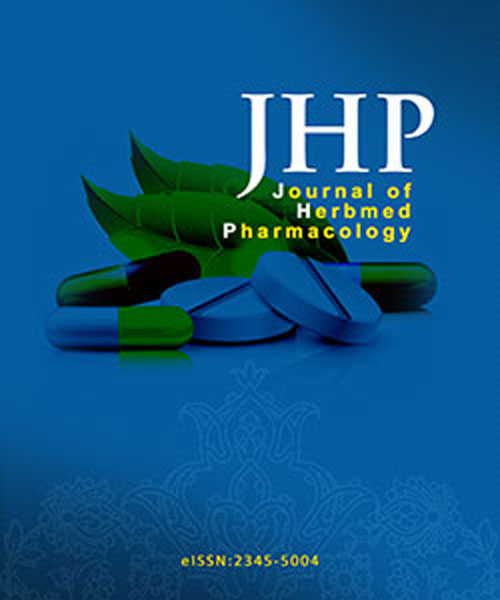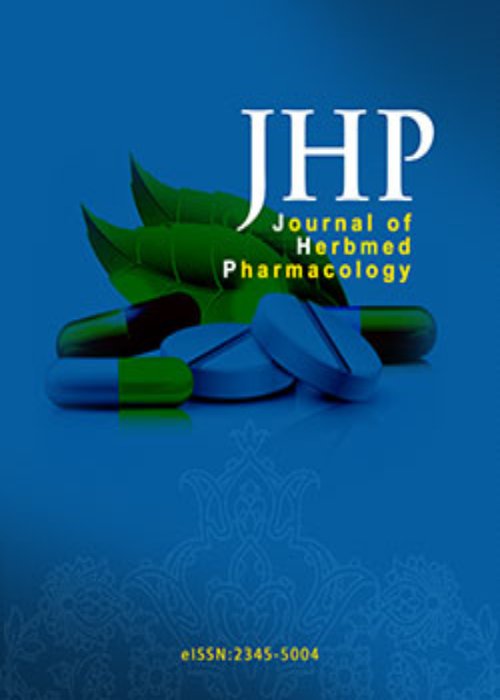فهرست مطالب

Journal of Herbmed Pharmacology
Volume:5 Issue: 1, Jan 2016
- تاریخ انتشار: 1394/09/20
- تعداد عناوین: 8
-
-
Pages 1-6Introduction
The objective of the study was to assess the potential of the leaf of Dicranopteris linearis in altering the CNS functions with three different extracts; aqueous, ethanol and ethyl acetate.
MethodsTo evaluate and compare the activities Morris maze, elevated plus maze (EPM),open field, hole cross and head dip tests were performed and many behavioral parameters wereobserved. The forced swim in Morris water maze analyzed the depression of rodents in termsof inability to self-rescue. Alongside, hole cross and open field tests assessed the inhibition oflocomotor activities. Moreover, EPM test screened the anxiolytic potential while the head dippinghole board test supported the previous experiments by evaluating both sedative, depressive andanxiolytic potentials of the extracts.
ResultsThe results showed that the ethanol extract significantly suppressed CNS activity byreducing number of locomotor activities and increasing the stability phase (in EPM and Morrismaze) supporting mild sedation, depression and anxiolysis. Furthermore, the ethyl acetate extractalso possessed moderate to high potential in reducing locomotor activities depending on gradientdoses. Results were compared with control group and found statistically significant.
ConclusionAs this plant mimic the activity of a gamma-aminobutyric acid (GABA) agonist, itcan be concluded that the plant may have GABA mediated involvement in central nervous system.However, the responsible compounds for these activities are yet to be investigated and this maypotentiate a new source of drug development.
Keywords: Dicranopteris linearis, Maze test, Hole cross, Open field, Head dipping -
Pages 7-11IntroductionIn order to scrutinize the anti-microbial and anti-inf lammatory agents, manyresearch groups have focused their works on the field of immunopharmacology. Thus, the currentstudy aimed to evaluate the immunopharmacological activity of aqueous root extract of Santalumalbum against Hepatitis B surface antigen (HBsAg) and Newcastle disease virus (NDV) on humanperipheral blood mononuclear cells (PBMCs).MethodsVariable doses of aqueous root extract of Santalum album (0.5-30 mg/ml, 50 µl) were prepared using phosphate buffered saline (PBS) and tested for proliferation assay, nitric oxideproduction and CD14 monocyte surface marker using flow cytometry.ResultsAqueous root extract of Santalum album inhibited proliferation, nitric oxide productionand CD14 monocyte surface marker at higher doses.ConclusionAqueous root extract of Santalum album possesses both anti-inf lammatory as well asantiviral activities and might be used for these purposes.Keywords: Santalum album_Hepatitis B vaccine_NDV_Aqueous extract
-
Pages 12-16IntroductionFrankincense has been shown to possess anti-inf lammatory activity. In this studythe effect of pretreatment with the hydro-alcoholic extract of frankincense on memory retrievalwas assessed in lipopolysaccharide (LPS) treated rats.MethodsForty-two adult male Wistar rats were distributed into 7 groups of 6 each. One groupreceived LPS (1 mg/kg; i.p) pre-test. The control group received saline (1 ml/kg; i.p). 2 groups ofanimals received frankincense (50 mg/kg; P.O) or DMSO 5% (1 ml/kg; P.O) and 30 minutes laterLPS (1 mg/kg; i.p). Two other groups of animals received frankincense (50 mg/kg; P.O) or DMSO5% (1 ml/kg; P.O) and 30 minutes later saline (1 ml/kg; i.p). Another group of rats received LPS(1 mg/kg; i.p) and 30 minutes later Ibuprofen (100 mg/kg; P.O). In all the experimental groups,memory retrieval was assessed 4 hours following the last injection, using a passive avoidancetask (PAT). Hippocampal TNF-α levels were measured by ELISA as an index of LPS-inducedneuroinf lammation.ResultsLPS impaired memory retrieval by decreasing step-through latency (STL), significantly.LPS also increased levels of TNF-α in the hippocampus as compared to the control group.Administration of frankincense (50 mg/kg; P.O) before LPS (1 mg/kg; i.p) improved memoryretrieval as compared to the control group. Frankincense reduced hippocampal TNF-α level in theLPS treated rats, significantly, compared to the control group.ConclusionThe results indicate that the hydro-alcoholic extract of frankincense has the potentialto improve memory retrieval in LPS treated rats, possibly via an anti-neuroinf lammatory activity.Keywords: Lipopolysaccharide, Memory, Frankincense, Neuroinflammation
-
Pages 17-22IntroductionDiabetes is one of the most prevalent metabolic disorders which is associated withseveral complications in different organs. Nowadays, medicinal herbs are being widely used totreat diseases. This study was conducted to study the hypoglycemic effect of Satureja montanum in diabetic male rats.MethodsIn this study 42 male Wistar rats were randomly assigned to 7 equal groups includingcontrol, diabetic control, treatments 1, 2, and 3, metformin-treated diabetic, and healthytreated with Satureja montanum. To induce diabetes streptozotocin (STZ) at 60 mg/kg wasintraperitoneally (ip) administered. The animals were treated daily with Satureja montanumextract (ip) for one week and their blood glucose was measured daily.ResultsSatureja montanum extract could significantly decrease blood glucose. The greatest effectof the extract was seen on day 8 at 800 mg/kg (P < 0.001). Satureja montanum extract caused asignificant increase in serum insulin compared to the control group (P < 0. 001).ConclusionThe findings of this study indicate that Satureja montanum hydroethanolic extractis able to significantly decrease blood glucose of diabetic rats possibly with a stimulatory effect onbeta cells.Keywords: Satureja montanum L., Diabetes, Streptozocin, Rat
-
Pages 23-28IntroductionThe Phoenix dactylifera or date palm pollen (DPP) is widely used for male infertilityin traditional medicine. The aim of this study was to evaluate the effect of DPP on fertility and development of female reproductive system in Balb/C mice.MethodsTen groups were assigned to 2 control and 8 experimental groups. On the control groups1 and 2 no treatment was conducted, but in the control group 2, after 10 days the mice were mated.In experimental groups 1 and 2, the animals received DPP (100 and 200 mg/kg, respectively) byoral administration for 10 days. In experimental groups 3 and 4 percentage of mating was evaluatedafter 10 days. Experimental groups 5 and 6 received DPP during gestation. Embryos were removedto evaluate ovaries histology. For experimental groups 7 and 8, DPP was administered until 21thday after birth. The offspring ovaries were removed to evaluate histological parameters. The levelsof sexual hormones were also measured.ResultsSeveral parameters of ovaries in offspring, including mass index, diameter of ovaries,number of primary and secondary graph follicles and corpora luteal, percentage of mating, bodymass index and Crown rump (CR) of embryos, diameter of ovary, basic sexual cell number inembryos, and mass index increased in experimental groups in comparison to the controls.However, luteinizing hormone (LH) and follicle-stimulating hormone (FSH) in the experimentalgroups were not significantly different from those in control groups (P > 0.05), while estrogen andprogesterone considerably increased in experimental groups (P < 0.05).ConclusionResults of our investigation propose that DPP can create an appropriate situationfor oogenesis and maintain efficient fertility in female mice which it may be considered as usefulnutraceuticals for potentiation of fertility in future human studies.Keywords: Palm pollen, Fertility, Balb, C
-
Pages 29-32IntroductionArtemisia absinthium L. (AA) is a large, diverse genus of the family Asteraceae. AAhas long been used as customary herbal medicine in world for the treatment of gastric pain, cardiacstimulation, improvement of memory and for the restoration of declined mental function. The aimof present study was to evaluate the hepatoprotective effects of AA on some factors ref lecting thedevelopment of oxidative toxic stress in plasma.MethodsTwenty male rats were equally divided in to 4 groups (5 rats each). Group I actedas control (received normal salin). Treatment groups were II, III and IV which were givenArtemisia 10, 50 and 100 mg/kg/day respectively only by gavage for 24 hours. After treatment,blood specimens were collected. Liver enzymes such as aspartate aminotransferase (AST) andalanine aminotransferase (ALT) with total antioxidant power (TAP) and total thiol groups (TTG)concentrations were measured.ResultsLevels of ALT, AST and TTG were decreased in the group II compared to the control(group I). ALT and AST in 50 mg/kg group was observed compared with control group. Also, TTGincreased in Artemisia 50 mg/kg group compared to control group.ConclusionResults suggests that alcoholic extract of Artemisia can ameliorate liver toxicity inrats through reducing the serum levels of ALT, AST, and oxidative damage.Keywords: Artemisia, Oxidative toxic stress, ALT, AST, Rat
-
Pages 33-38IntroductionMoringa oleifera is a small tree with very significant nutritional but alsopharmacological properties and various preparations from almost all parts of the plant (leaves,fruit, stems, bark, roots) are used in folk medicine for treating several ailments. This study aimedto investigating the polyphenolic burden and in vitro antioxidant properties of M. oleifera rootextracts, obtained with solvents covering a range of polarities.MethodsLyophilised Moringa oleifera roots were extracted with solvents of increasing polarity,including ethyl acetate, butanol, methanol and water. The generated extracts were screened forpolyphenolic load and antioxidant activities, by determining the total polyphenol, total f lavonoid,total f lavanol, antiradical activity and reducing power. Liquid chromatography-mass spectrometrywas also employed to obtain some evidence regarding the nature of the main constituents.ResultsThe results indicated that both aqueous and methanolic extracts were the richestin total polyphenols, but the aqueous extract also exhibited high reducing power. The liquidchromatography-diode array-mass spectrometry analysis also revealed that the major substancesoccurring in the aqueous extract were relatively polar molecules, but the mass spectral data wereambiguous to assign tentative structures.ConclusionPolar solvents, such as water, may be effectively used to recover high amounts of M.oleifera root phenolics, which possess important antioxidant properties.Keywords: Antioxidant, Moringa oleifera roots, Polyphenols
-
Pages 39-44Background And AimsToday, cardiovascular diseases are the prominent cause of death in industrialized countries which include a variety of diseases such as hypertension, hyperlipidemia, thromboembolism, coronary heart disease, heart failure, etc. Recent research findings haveshown that not only the extent of cultivation and production of medicinal plants have not beenreduced, but also day-to-day production and consumption have increased. In traditional botanicalknowledge, herbal medicines are used for the treatment of cardiovascular disorders. In this study,we sought to gather and report medicinal plants used to treat these diseases in different regionsof Iran.MethodsThe articles published about ethnobotanical study of cardiovascular diseases in variousregions of Iran, such as Arasbaran, Sistan, Kashan, Kerman, Isfahan Mobarakeh, Lorestan andIlam were prepared and summarized.ResultsThe results of ethnobotanical studies of various regions of Iran, such as Arasbaran, Sistan,Kashan, Kerman, Isfahan Mobarakeh, Lorestan and Ilam were gathered. The results showed thatsumac plants, barberry, yarrow, wild cucumber, horsetail, Eastern grape, hawthorn, wild rose,spinach, jujube, buckwheat, chamomile, chicory, thistle, Mary peas, nightshade, verbena, sorrel, cherry, citrullus colocynthis, Peganum harmala, sesame and so many other plants are used for thetreatment of cardiovascular diseases and disorders.ConclusionHerbal medicines are used effectively for some cardiovascular diseases. Rigoroustraining of patients to take precautions and drug interactions into account and to avoid thearbitrary use of medicinal plants is very important.Keywords: Cardiovascular disorders, Hypertension, Hyperlipidemia, Diabetes, Herbs, Iran


